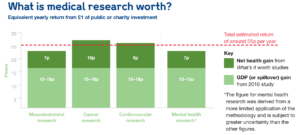Additional resources
This page provides links to a number of external reports and databases which are of relevance to those using the HRCS, analysing portfolios of research data or interested in the landscape of medical research in the UK and globally. This includes the “Medical Research: What’s it worth?” report series, alongside international research award databases for the WHO Global Observatory and World RePORT.
As resource for others, if you have other examples that would be helpful to fellow researchers you would like to see included here, please contact us so we can include them.
Medical research: what’s it worth? – the economic benefits of medical research
From 2008 to 2018, a series of academic studies were published estimating the economic benefits of medical research. The first report, commissioned by the UK Evaluation Forum (MRC, Wellcome Trust and Academy of Medical Sciences), was published in 2008 and investigated the return on investment for cardiovascular and mental health research spending[1]. The second in the series – on cancer research – was published in 2014[2] and concluded with a third on musculoskeletal research in 2018[3]. All three reports were a collaboration between three academic/commercial partners; Policy Institute at King’s College London, RAND Europe, and the Health Economics Research Group at Brunel University London. In addition, a companion paper from the same researchers (alongside colleagues in the Department of Economics, University of York) published in 2016 and sought to assess the ‘spillover’ benefits of medical research to the UK economy[4].
The combined results provided a estimated rate of return for improved health outcomes in cardiovascular, cancer, mental health and musculoskeletal of between 7% and 10%. When included with the ~17% return for the broader economic or ‘spillover’ impact the rate of return rises to between 24% and 27%. In other words, for every pound invested in medical research the estimated return to the economy is between 24 and 27 pence, per annum, in perpetuity.

The above chart comes from a briefing document – produced by the supporting funding organisations – which summarises the results from all four reports.
[1]Health Economics Research Group et al. Medical Research: What’s it worth? Estimating the economic benefits from medical research in the UK. London: UK Evaluation Forum; 2008.
[2]Glover M. et al. Estimating the returns to UK publicly funded cancer-related research in terms of the net value of improved health outcomes. BMC Med. 2014;12:99
[3]Glover M. et al. Estimating the returns to UK publicly funded musculoskeletal disease research in terms of net value of improved health outcomes. Health Res Policy Syst. 2018.
[4]Sussex J. Quantifying the economic impact of government and charity funding of medical research on private research and development funding in the United Kingdom. BMC Med. 2016;14:32.
WHO Global Observatory
World Health Organisation Global Observatory of Health R&D is a centralised and comprehensive source of information and analyses on global health R&D activities for human diseases. It builds on existing data and reports from a wide range of data sources, and gathers new information (where needed and feasbile) with the aim of enabling decisions on priorities in R&D.
World RePORT
World RePORT is an open-access, interactive mapping database project highlighting biomedical research investments and partnerships from some of the world’s largest funding organisations. An initial effort was undertaken by of the Heads of International Research Organizations (HIROs), and focused on research performed in Sub-Saharan Africa using data supplied by members.
While the investments made in low- and middle-income countries (LMICs) remain the focus of World RePORT, the effort was expanded in 2015 to provide a global view of directly funded research grants, and indirectly funded research collaborations in all LMICs. Data is collated on an annual basis, with the latest dataset of 2018 awards released in September 2019.
